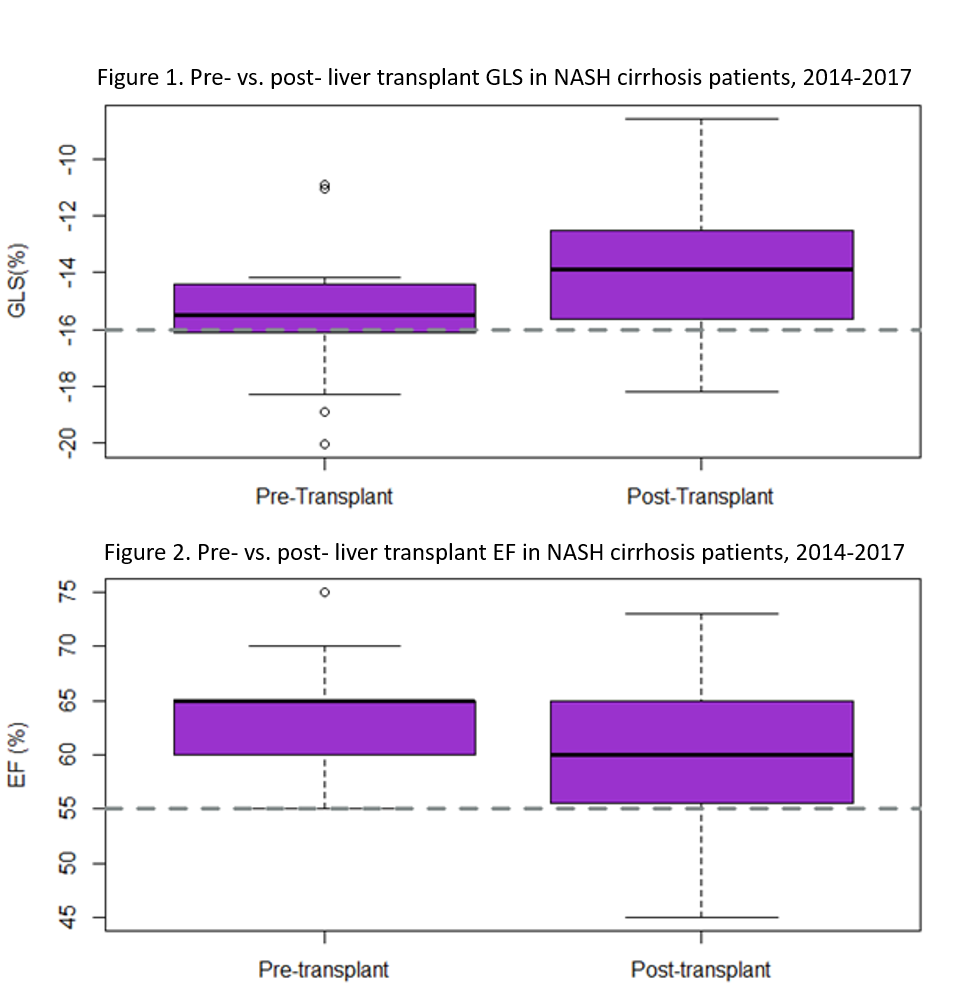Analyzing The Effect Of Liver Transplantation On Myocardial Strain Using Speckle Tracking Echocardiography In Nonalcoholic Steatohepatitis (NASH) Patients
Northwestern Memorial Hospital, Chicago, IL
Meeting: 2019 American Transplant Congress
Abstract number: B321
Keywords: Echocardiography, Heart, Hemodynamics, Outcome
Session Information
Session Name: Poster Session B: Liver Retransplantation and Other Complications
Session Type: Poster Session
Date: Sunday, June 2, 2019
Session Time: 6:00pm-7:00pm
 Presentation Time: 6:00pm-7:00pm
Presentation Time: 6:00pm-7:00pm
Location: Hall C & D
*Purpose: Nonalcoholic Steatohepatitis (NASH) is currently the second most common indication for liver transplant in the United States and is projected to increase in the setting of the obesity epidemic. Cardiac dysfunction is common in these patients, typically characterized by impaired myocardial contractility and diastolic dysfunction. However, changes in these parameters in relation to liver transplant remains unclear. This study utilizes a new technique, Speckle-Tracking Echocardiography (STE), to compare pre- and post-transplant cardiac contractility in NASH patients.
*Methods: The patients selected for this study underwent a liver transplant at a tertiary referral center between the years of 2014-2017, had a diagnosis of NASH based on explant, and had pre- and post-transplant echocardiograms available for review. STE was used to measure Global Longitudinal Strain (GLS) and Ejection Fraction (EF) by tracking speckles in the myocardium during the cardiac cycle. The echocardiograms closest to the date of transplant were evaluated by an experienced cardiologist for GLS and EF using TomTec STE software. Paired t-tests were used for statistical inference.
*Results: Seventeen patients were included in the study. Their ages were between 48 and 73, with a median age of 66; nine were male and eight were female. Echocardiograms were recorded on average 167 (IQR 21-176) days before the transplant and 95 (IQR 9-87) days after the transplant. A trend of worsening GLS (normal: -16% to -24%) was observed with a mean of -15.49% (SD 2.40) pre-transplant and -13.88% (SD 2.60) post-transplant (p-value = 0.054). There was a similar trend of decreasing EF (normal: >55%), which had a mean of 64.12% (SD 5.37) pre-transplant and 60.19% (SD 6.30) post-transplant (p-value = 0.067).
*Conclusions: In NASH patients, EF trended towards normal after liver transplant but contractility, as measured by GLS, did not. This could signify persistent cardiac dysfunction despite the reversal of cirrhosis via transplantation.
To cite this abstract in AMA style:
Chhatriwala A, Lam M, Kim E, Raissi S, Mazumder N, Thomas J, Maddur H, Rinella M. Analyzing The Effect Of Liver Transplantation On Myocardial Strain Using Speckle Tracking Echocardiography In Nonalcoholic Steatohepatitis (NASH) Patients [abstract]. Am J Transplant. 2019; 19 (suppl 3). https://atcmeetingabstracts.com/abstract/analyzing-the-effect-of-liver-transplantation-on-myocardial-strain-using-speckle-tracking-echocardiography-in-nonalcoholic-steatohepatitis-nash-patients/. Accessed December 14, 2025.« Back to 2019 American Transplant Congress

